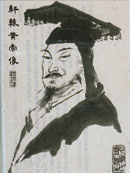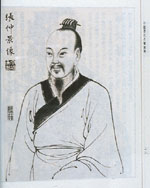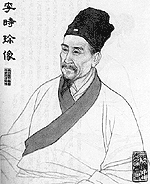

To this legendary emperor is attributed the earliest known Chinese medical writing, Huang-ti Nei ching (The Canon of Internal Medicine). This work consists of two treatises, one a dialogue about living matter between Huang Ti and his minister Qibo, and the other a description of medical physiology, anatomy, and acupuncture. This famous classic is considered to be the bible of traditional Chinese medicine but its true authorship is unkown.

Considered to be the father of Chinese agriculture, this legendary emperor taught his people how to cultivate grains as food, so as to avoid killing animals. He is said to have tasted hundreds of herbs to test their medicinal value, and is assumed to be the author of Shen-nung pen ts'ao ching (Divine Husbandman's Materia Medica), the earliest extant Chinese pharmacopoeia. This text includes 365 medicines derived from minerals, plants, and animals. The true authorship of this work is also unknown.
Shen Nung is venerated as the Father of Chinese medicine. He is believed to have introduced the technique of acupuncture.

Regarded as one of the great physicians of the Han dynasty (206 BC-220 AD), the most glorious period in Chinese medical history, Chang Chung-ching wrote Shang han lun (Treatise on Colds and Fevers). This work had a profound influence on Chinese medicine and is considered to be the most important medical classic after the Huang-ti Nei ching. Chang Chung-ching is called the Hippocrates of China.

Chinese medicine seems to have reached its peak during the Ming dynasty (1368-1644) when Li Shih-chen wrote his Pen ts'ao kang mu (The Great Herbal). This great pharmacopoeia, which summarizes what was known of herbal medicine up to the late 16th century, describes in detail more than 1800 plants, animal substances, minerals, and metals, along with their medicinal properties and applications. Li Shih-chen was 35 years old when he began to compile his Pen ts'ao kang mu. He took 27 years to finish it.
Chinese Medicine Home | History of Medicine Home | All Exhibitions by Subjects
U.S. National Library of Medicine, 8600 Rockville Pike, Bethesda, MD 20894
National Institutes of Health
Department of Health & Human Services
Copyright, Privacy, Accessibility
Last updated: 10 January 2008